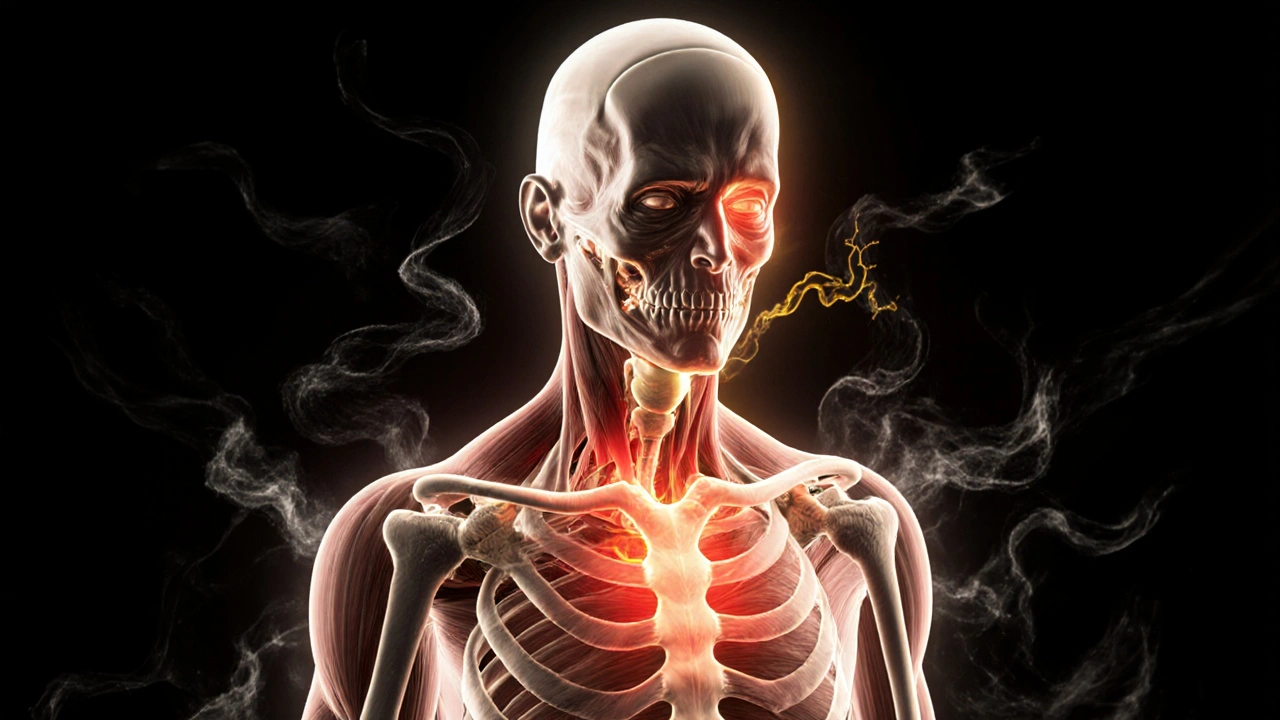How Neuromuscular Massage Helps Reduce Stress and Tension
 Nov, 15 2025
Nov, 15 2025
Stress Tension Estimator
Identify which muscles are holding your stress and estimate your tension level with personalized recommendations for neuromuscular massage.
Select Your Tension Areas
Stress doesn’t just live in your mind-it settles in your muscles. If you’ve ever felt a knot in your shoulder that won’t budge, or a tight jaw that aches all day, you know stress isn’t just emotional. It’s physical. And one of the most effective ways to break that cycle isn’t meditation or breathing exercises-it’s neuromuscular massage.
What Neuromuscular Massage Actually Does
Neuromuscular massage isn’t just deep pressure. It’s targeted therapy that works directly on the connection between your nerves and muscles. When you’re under chronic stress, your body stays in fight-or-flight mode. Your muscles tighten to protect you. Over time, this creates trigger points-hyperirritable spots in muscle tissue that send pain signals to your brain, even when there’s no injury.
Neuromuscular massage uses focused pressure on these trigger points, usually with the therapist’s thumbs, knuckles, or elbows. The goal isn’t to hurt you-it’s to reset the nervous system. By holding pressure for 10 to 30 seconds, the therapist interrupts the pain-spasm cycle. Blood flow returns. The muscle releases. And your brain gets the signal: you’re safe now.
Unlike Swedish massage, which is about relaxation, neuromuscular massage is about correction. It’s the difference between soothing a burn and fixing a broken wire.
Why It Works Better Than Regular Massage for Stress
Most people think massage is just about feeling good. And yes, a good rubdown lowers cortisol. But neuromuscular massage goes deeper-literally. Studies show it reduces muscle tension by up to 40% in just one session, especially in areas like the upper trapezius, levator scapulae, and suboccipitals-the muscles that lock up first when you’re anxious.
Here’s how it stacks up against other types:
| Massage Type | Primary Goal | Pressure Level | Best For Stress? |
|---|---|---|---|
| Swedish | Relaxation | Light to moderate | Yes, for mild stress |
| Deep Tissue | Break down adhesions | Heavy | Partial-can be too intense |
| Neuromuscular | Reset nerve-muscle signals | Variable, precise | Yes-most effective |
| Trigger Point | Release localized knots | Focused | Yes, but narrower scope |
Neuromuscular massage targets the root cause: misfiring nerves. When your nervous system is stuck in overdrive, your muscles stay contracted. This isn’t just discomfort-it’s a feedback loop. Pain → stress → more tension → more pain. Neuromuscular massage breaks that loop by teaching your body to relax again.
Where Stress Shows Up in Your Body
Most people think stress causes headaches or sleeplessness. But if you’ve ever had a tension headache that started at the base of your skull, or back pain that flares up during deadlines, you’re seeing the real signs.
Here’s where stress hides in your muscles:
- Upper trapezius-the muscle from your neck to your shoulder. Tight here = constant shoulder pain and migraines.
- Levator scapulae-runs from your neck to your shoulder blade. Tight here = stiff neck, difficulty turning your head.
- Suboccipitals-tiny muscles at the base of your skull. Tight here = dizziness, blurred vision, tension headaches.
- Pectoralis minor-under your chest. Tight here = shallow breathing, anxiety spikes.
- Iliopsoas-deep hip flexor. Tight here = lower back pain and emotional tension.
Neuromuscular massage doesn’t just massage these areas-it reprograms them. A skilled therapist doesn’t just push. They listen. They feel for the tissue that won’t yield, and they hold. That’s when the magic happens: the muscle lets go, not because it’s forced, but because the nervous system finally believes it’s safe.
What Happens After a Session
After a neuromuscular massage, you might feel a little sore-like after a good workout. That’s normal. But within 24 to 48 hours, most people report:
- Deeper, easier breathing
- Less jaw clenching
- Improved sleep quality
- Reduced anxiety spikes
- Less reliance on caffeine to stay alert
One client in Wellington, a software developer who worked 12-hour days, came in with chronic migraines and insomnia. After four weekly sessions, she stopped taking painkillers. She didn’t meditate more. She didn’t change her diet. She just stopped holding her body like it was under threat.
That’s the power of neuromuscular massage. It doesn’t distract you from stress. It undoes it.

Who Should Try It (and Who Should Avoid It)
Neuromuscular massage is ideal for:
- People with chronic tension headaches or migraines
- Those with desk jobs, long commutes, or repetitive motion work
- Anyone who feels constantly on edge, even when nothing’s happening
- People who’ve tried yoga, stretching, or therapy but still carry physical tension
It’s not for everyone. Avoid it if you have:
- Recent injuries or fractures
- Blood clotting disorders
- Severe osteoporosis
- Active infections or fever
- Uncontrolled high blood pressure
If you’re pregnant, have cancer, or take blood thinners, talk to your doctor first. A good therapist will ask these questions before you lie down.
How to Find a Qualified Therapist
Not all massage therapists are trained in neuromuscular techniques. Look for credentials like:
- Certification in Neuromuscular Therapy (NMT)
- Training from the National Association of Myofascial Trigger Point Therapists
- Background in anatomy and physiology
Ask them: "Do you use trigger point therapy and nerve pressure techniques?" If they look confused, keep looking. A good therapist will explain how they identify trigger points and why they hold pressure for a specific time.
In Wellington, clinics like BodyLogic and The Muscle Clinic have therapists trained in NMT. But don’t just pick the cheapest. This isn’t a luxury-it’s a reset for your nervous system.
What to Expect on Your First Visit
Your first session usually lasts 60 to 90 minutes. You’ll fill out a health history form. The therapist will ask about your stress triggers, pain locations, and sleep patterns. They won’t just massage you-they’ll assess your posture, breathing, and movement.
You’ll lie on a table, fully clothed or draped. No oil, no music, no aromatherapy-unless you want it. The focus is on tissue, not ambiance.
They’ll start with light pressure to find tight spots. Then they’ll apply sustained pressure. You might feel a sharp sensation, but it shouldn’t be unbearable. If it is, speak up. Good therapists work within your tolerance.
Afterward, they’ll give you simple stretches and hydration tips. You’ll leave feeling tired but lighter-like you just took a weight off your shoulders.

How Often Should You Get It?
For acute stress: once a week for 3 to 4 weeks.
For maintenance: once a month.
Think of it like dental cleaning. You don’t wait until your tooth falls out to see a dentist. Same with your muscles. If you’re under constant stress, your body needs regular recalibration.
Some people notice changes after one session. Others need three. It depends on how long the tension has been there. But most people agree: after the third session, they feel like they’ve been given back their body.
Can You Do It Yourself?
You can’t fully replicate neuromuscular massage at home. But you can support it. Use a lacrosse ball or foam roller on your upper back, shoulders, or hips for 20 seconds per spot. Breathe deeply while you roll. Don’t bounce. Just hold and relax.
Stretching helps too. Try the doorway chest stretch or neck releases. But remember: self-care is support, not replacement. The nervous system responds best to skilled, external input.
Why This Isn’t Just Another Trend
Neuromuscular massage isn’t new. It’s been used since the 1930s by physical therapists and sports medicine specialists. What’s changed is awareness. More people now understand that stress isn’t just in the mind-it’s written in the muscles.
This isn’t about spa days. It’s about reclaiming your body from the silent damage of modern life. If you’re tired of managing stress, maybe it’s time to stop managing it-and start undoing it.
Can neuromuscular massage help with anxiety?
Yes. Anxiety often manifests as physical tension-tight shoulders, clenched jaw, shallow breathing. Neuromuscular massage directly addresses this by resetting the nervous system. When muscles release, the brain receives a signal that the body is no longer under threat. This reduces cortisol levels and calms the fight-or-flight response. Many clients report feeling less anxious within hours of a session.
Is neuromuscular massage painful?
It can be uncomfortable, but it shouldn’t be unbearable. The pressure is deep and focused, often described as a "good hurt." A skilled therapist adjusts pressure based on your feedback. If it feels like pain, not release, tell them. The goal isn’t to hurt you-it’s to help your body let go. Mild soreness afterward is normal, like after a workout.
How long do the effects last?
After one session, benefits typically last 3 to 7 days. With regular sessions-once a week for a month-the effects become cumulative. Muscle memory resets, and the nervous system learns to stay relaxed longer. For people with chronic stress, monthly maintenance sessions help sustain the results.
Do I need to undress for neuromuscular massage?
No. Most sessions are done with you fully clothed or lightly draped. You’ll wear comfortable clothing that allows access to your neck, shoulders, back, and hips. The therapist uses hands, knuckles, or elbows-no oils or sheets are needed. This makes it easier to assess posture and movement during the session.
Can neuromuscular massage replace therapy or medication?
It’s not a replacement, but it’s a powerful complement. If you’re in therapy for anxiety or depression, neuromuscular massage can help release the physical tension that often blocks emotional progress. It doesn’t replace talk therapy or medication, but it removes a major barrier: the body’s constant state of alert. Many therapists work alongside counselors to support holistic healing.
